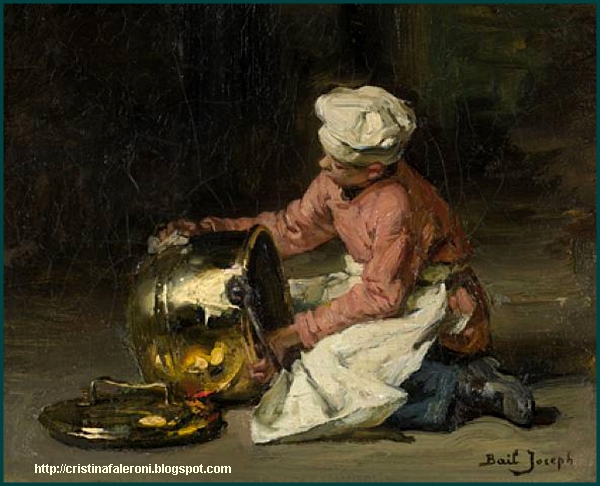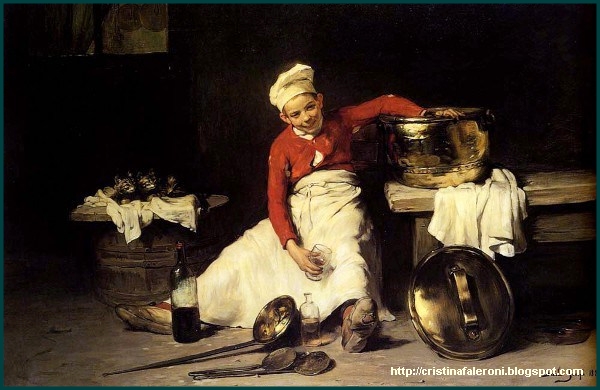Biography:
Claude Joseph Bail initial artistic education came from his father, Jean Antoine Bail, a painter from Lyon who was an excellent intimist teacher. From a very early age, he lived on traditions offered to him by his town of birth and from the creative home atmosphere. He thus painted sparkling objects, adorned with rich, beautiful colours. During the 1880’s, he moved up to Paris where he worked under the supervision of Gérôme and Carolus-Duran. His first successes date from 1878 when he started exhibiting his work at the “Salon des Artistes Français”. He obtained numerous awards, including the third class medal in 1886, a second class one in 1887; in 1889 he was awarded with a silver medal and in 1900, he won a gold medal at the “Exposition Universelle”. These awards ensured him recognition and guaranteed commission from the bourgeoisie. His style is totally focused on the past and with his great sense of realism, he is yet again rewarded in 1902, at the “Salon des Artistes Français”, where he wins a medal of honour for his painting entitled “Les dentellières” (“The Lacemakers”). During this period he starts his large canvasses, amongst which the “L’hospice de Beaune”. Joseph Bail remained in critics and collecters’ favour until the First World War, being seen as a witness to traditions, at the time when these values were greatly disrupted by the emergence of modernism. . Finally he was nominated Chevalier of the Legion of Honour...//
Claude Joseph Bail initial artistic education came from his father, Jean Antoine Bail, a painter from Lyon who was an excellent intimist teacher. From a very early age, he lived on traditions offered to him by his town of birth and from the creative home atmosphere. He thus painted sparkling objects, adorned with rich, beautiful colours. During the 1880’s, he moved up to Paris where he worked under the supervision of Gérôme and Carolus-Duran. His first successes date from 1878 when he started exhibiting his work at the “Salon des Artistes Français”. He obtained numerous awards, including the third class medal in 1886, a second class one in 1887; in 1889 he was awarded with a silver medal and in 1900, he won a gold medal at the “Exposition Universelle”. These awards ensured him recognition and guaranteed commission from the bourgeoisie. His style is totally focused on the past and with his great sense of realism, he is yet again rewarded in 1902, at the “Salon des Artistes Français”, where he wins a medal of honour for his painting entitled “Les dentellières” (“The Lacemakers”). During this period he starts his large canvasses, amongst which the “L’hospice de Beaune”. Joseph Bail remained in critics and collecters’ favour until the First World War, being seen as a witness to traditions, at the time when these values were greatly disrupted by the emergence of modernism. . Finally he was nominated Chevalier of the Legion of Honour...//
...//Joseh Bail paints discrete interiors, active bedrooms and kitchens where the housewives dressed in big white hats are busy with preparations, workshops where the agile fingers of the lacemakers run swiftly over the machines. He plays with the light on clothes and objects using a technique which can also be admired in the works of Flemish XVIIth Century painters, such as Frans Hals. He was also very inspired by the work of Jean-Baptiste Chardin, whose canvasses were animated by a skilful game of contrasts. His excellent brushwork enabled him to play on the reflection of the stained-glass windows on the metallic or crystalline shine of goblets, copperware and glassworks. The quiet, intimate lives which humble, gentle women devote to household tasks, or to sewing or embroidery- this intimist painter knew how to depict this with the poetry of a warm contemplation. This accomplished painter, whose confident hand is outstanding, obliges us to admire what he manages to portray so accurately, suited to shadows and light, to reflections which give light to sparkling objects. His characters themselves stand out as visible silhouettes in the peace of the setting.













No hay comentarios.:
Publicar un comentario